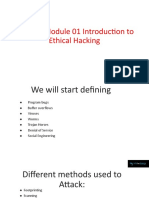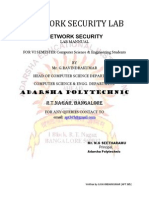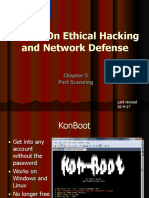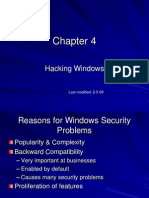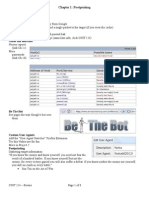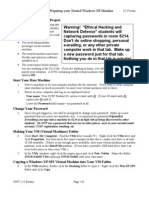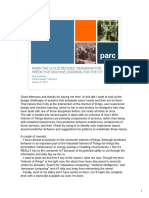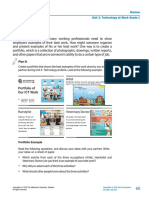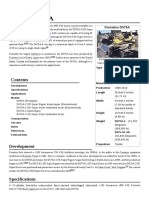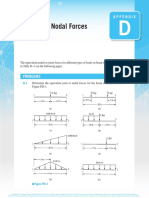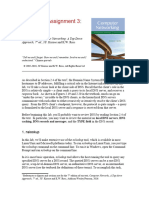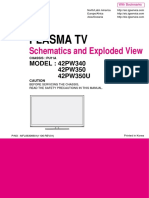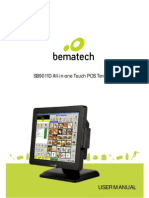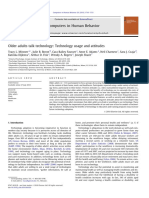Chapter 3
Enumeration
Last modified 1-30-09
�Definition
Scanning identifies live hosts and running services Enumeration probes the identified services more fully for known weaknesses Enumeration is more intrusive, using active connections and directed queries Enumeration will usually be logged and noticed
�Goals of Enumeration
User account names
to inform subsequent password-guessing attacks
Oft-misconfigured shared resources
for example, unsecured file shares
Older software versions with known security vulnerabilities
such as web servers with remote buffer overflows
�Pen-Test Video
Link Ch 3a: Droop's Box: Simple Pen-test Using Nmap, Nikto, Bugtraq, Nslookup and Other Tools by IronGeek
�Telnet in Vista and Windows 7
First you need to install Telnet
In Control Panel, Programs and Features, Turn Windows Features on or off, check Telnet Client
�Banner Grabbing
Connecting to remote applications and observing the output Simple way, at a command prompt
telnet www.ccsf.edu 80
On the next blank screen type in
GET / HTTP/1.1 Press Enter twice
�Making Characters Visible
In Windows XP and Vista, you can't see what you type in the Telnet session Do this:
At a command prompt, type
telnet hills.ccsf.edu 80
Press Enter. Press Ctrl+]. Then type
set localecho
Press Enter twice
Link Ch 3z11
�Example Banners
www.ccsf.edu tells you too much
cnn.com is better
�Netcat Banner Grabs
Get Netcat for Windows at links Ch 3d, 3d1, 3d2
�Banner-Grabbing Countermeasures
Turn off unnecessary services Disable the presentation the vendor and version in banners Audit yourself regularly with port scans and raw netcat connects to active ports
�Enumerating Common Network Services
FTP Enumeration, TCP 21 Enumerating SMTP, TCP 25 DNS Zone Transfers, TCP 53 Enumerating TFTP, TCP/UDP 69 Finger, TCP/UDP 79 Enumerating HTTP, TCP 80
�FTP Enumeration, TCP 21
CCSF doesn't give away much information FTP is becoming obsolete, see ftp.sun.com FTP passwords are sent in the clear
Don't allow anonymous uploads Turn it off, use secure FTP instead
�Googling for FTP Servers
Search for
intitle:"Index of ftp://"
Here's an overly informative HTTP banner
�FTP Banner
Here's the corresponding overly informative FTP banner
�Enumerating SMTP, TCP 25
SMTP can be enumerated with Telnet, using these commands
VRFY confirms names of valid users EXPN reveals the actual delivery addresses of aliases and mailing lists
�Antivirus Note
McAfee antivirus blocks telnets to port 25 "Prevent mass mailing worms from sending mail"
�SMTP Enumeration Countermeasures
Disable the EXPN and VRFY commands, or restrict them to authenticated users Sendmail and Exchange both allow that in modern versions
�DNS Zone Transfers, TCP 53
Zone transfers dump the entire contents of a given domain's zone files Restricted to authorized machines on most DNS servers now
�Enumerating TFTP, TCP/UDP 69
TFTP is inherently insecure
Runs in cleartext No authentication at all Anyone can grab any file Used in routers and VoIP Telephones to update firmware
�TFTP Enumeration Countermeasures
Wrap it to restrict access
Using a tool such as TCP Wrappers TCP Wrappers is like a software firewall, only allowing certain clients to access a service Links Ch 3e, 3f
Limit access to the /tftpboot directory Make sure it's blocked at the border firewall
�Finger, TCP/UDP 79
Shows users on local or remote systems, if enabled
Useful for social engineering
Countermeasure: block remote access to finger
�Enumerating HTTP, TCP 80
Grab banners with netcat or telnet Crawl Web sites with Sam Spade
�HTTP Enumeration Countermeasures
Change the banner on your web servers
URLScan for IIS v 4 and later
Link Ch 3h
�Microsoft RPC Endpoint Mapper (MSRPC), TCP 135
Remote Procedure Call (RPC) endpoint mapper (or portmapper) service on TCP 135 Querying this service can yield information about applications and services available on the target machine
�epdump
Shows services bound to IP addresses It takes some research to interpret the results
Link Ch 3n
�rpcdump
On the Backtrack 2 CD Start, Backtrack, Vulnerability Identification, All, RPCDump
Similar confusing results
�rpcdump Results
�MSRPC Enumeration Countermeasures
Block port 135 at the firewall, if you can
But some Microsoft Exchange configurations require access to the endpoint mapper You can avoid that by using Virtual Private Networks, or Outlook Web Access (OWA) which works over HTTPS
�NetBIOS Name Service, UDP 137
NetBIOS Name Service (NBNS) is Microsoft's name service, an alternative to DNS What is Name Resolution?
Suppose you issue a command that refers to a computer by name, such as PING
�Name Resolution
Windows needs to change a computer name to an IP address to send data packets Windows uses two naming systems:
DNS (the preferred method) NetBIOS Name Resolution (still used by all versions of Windows)
See link Ch 3v
�Standard Name Resolution Methods
Charts from link Ch 3v
�Additional Name Resolution Methods
�NET VIEW
NET VIEW can list the domains, or the computers in each domain
�NBNS over TCP/IP
Normally NBNS only works on the local network segment It is possible to route NBNS over TCP/IP, allowing enumeration from a remote system
�Other Tools to Enumerate NBNS
NLTEST and NETDOM can find domain controllers NETVIEWX finds specific services NBTSTAT collects information from a single system NBTSCAN scans a whole range of addresses, and dumps the whole NetBIOS name table
Link Ch 3w
�NBTSCAN
�Stopping NetBIOS Name Services Enumeration
All the preceding techniques operate over the NetBIOS Naming Service, UDP 137 Block UDP 137 at the firewall, or restrict it to only certain hosts To prevent user data from appearing in NetBIOS name table dumps, disable the Alerter and Messenger services on individual hosts Blocking UDP 137 will disable NBNS name authentication, of course
�NetBIOS Session, TCP 139
These are the notorious Null Sessions The Windows Server Message Block (SMB) protocol hands out a wealth of information freely Null Sessions are turned off by default in Win XP and later versions, but open in Win 2000 and NT
They aren't available in Win 95, 98, or Me Link Ch 3x, 3y, 3z00, 3z01
�Null Session Against Win 2000
�Information Available
Null sessions on Win 2000 and NT provide information about:
Shares User accounts Password policies
�DumpSec
Free from link Ch 3z02 Runs on Vista (and earlier Windows)
�Registry Enumeration
The Registry can be viewed remotely Requires Administrator privileges by default on Windows servers
You can't do it with null sessions
Gary McKinnon used remote registry access to hack into the Pentagon
Link Ch 3z03
�user2sid/sid2user
These utilities can get user account names and SIDs remotely, even if the registry key RestrictAnonymous is set to 1 They can find the Administrator's account name, even if it's renamed, by changing the last 3 numbers of another account's SID to 500
Works against Win 2003, but not Win XP SP2 See link Ch 3z04
�All-in-One Null Session Enumeration Tools
Winfo Newer tool:
NBTEnum 3.3 Link Ch 3z15
�SMB Null Session Countermeasures
Block TCP 139 and 445 at the router Set the RestrictAnonymous registry key to 1 or 2
HKLM\SYSTEM\CurrentControlSet\Control\LSA
Ensure the Registry Is Locked Down
http://support.microsoft.com/kb/153183 (link Ch 3z16)
�SNMP, UDP 161
Simple Network Management Protocol (SNMP) is intended for network management and monitoring
Administrators use SNMP to remotely manage routers and other network devices
But it has many security vulnerabilities
See links Ch 3z06, 3z07, 3z08
�Community Strings
SNMP is not a very secure protocol. It has a minimal security system called SNMP Community Strings Community strings act like passwords There are three kinds of SNMP Community strings: Read-Only, ReadWrite, and Trap (Trap is rarely used)
But the community strings are often left at obvious defaults like "public" and "private"
�Management Information Bases (MIBs)
The MIB contains a SNMP device's data in a treestructured form, like the Windows Registry Vendors add data to the MIB Microsoft stores Windows user account names in the MIB
Image from link Ch 3z07
�Data Available Via SNMP Enumeration
Running services Share names Share paths Comments on shares Usernames Domain name
�SNMP Enumeration Tools
snmputil from the Windows NT Resource Kit snmpget or snmpwalk for Unix IP Network Browser
Part of the Engineer's Toolset, link Ch 2d
�Worse than Enumeration
Attackers who guess the SNMP community string may be able to remotely control your network devices
That can be used for DoS attacks, or other attacks
�SNMP Enumeration Countermeasures
Remove or disable unneeded SNMP agents Change the community strings to nondefault values Block access to TCP and UDP ports 161 (SNMP GET/SET) Restrict access to SNMP agents to the appropriate management console IP address
�SNMP Enumeration Countermeasures
Use SNMP V3much more secure than V1
Provides enhanced encryption and authentication mechanisms
Adjust Win NT registry keys to make SNMP less dangerous
�BGP, TCP 179
Border Gateway Protocol (BGP) is the de facto routing protocol on the Internet Used by routers to help them guide packets to their destinations It can be used to find all the networks associated with a particular corporation
That may give you more targets to attack
A small risk, but there is no countermeasure
�Windows Active Directory LDAP, TCP/UDP 389 and 3268
Active Directory contains all user accounts and other information on Windows domain controllers If the domain is made compatible with earlier versions of Windows, such as Win NT Server, any domain member can enumerate Active Directory
�Active Directory Enumeration Countermeasures
Filter access to ports 389 and 3268 at the network border Use "Native" domainsdon't allow Win NT4 Domain Controllers
�Other Services Vulnerable to Enumeration
Novell NetWare Enumeration, TCP 524 and IPX UNIX RPC Enumeration, TCP/UDP 111 and 32771 rwho (UDP 513) and rusers (RPC Program 100002) NIS Enumeration, RPC Program 100004 SQL Resolution Service Enumeration, UDP 1434 NFS Enumeration, TCP/UDP 2049











